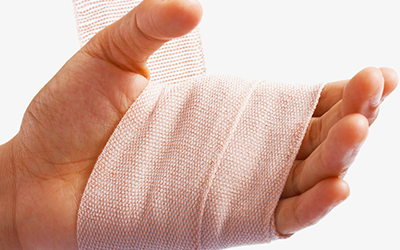Wrist and Hand Injuries

We often take our ability to function with our hands for granted. The adaptability and dexterity of movements of the wrist, hand and fingers on any given day are only realized if that ability has been limited by pain or injury. The anatomical makeup of the wrist/hand area is a complex array of bones, tendons, muscles, nerves, arteries, veins, ligaments and connective tissue.
Unfortunately the wrist and hand is frequently injured because of its constant use in most daily functions and tasks. We tend to however place less urgency on wrist and hand injuries and don’t appreciate that the failure to properly diagnose, treat and rehabilitate wrist and hand injuries could have long term effects and possible disability.
Why hand is vulnerable to injuries?
The wrist and hand is comprised of 27 bones that act dynamically and independently to allow for oppositional gripping and grasping. The twenty seven bones are arranged into 8 Carpal bones, 5 Metacarpal bones and 14 bones that make up the 5 fingers. The major flexor and extensor muscles and tendons that serve the wrist and hand originate in the elbow. The flexor tendons originate from the medial condyle of the elbow and pass through channels over the palmar aspect of the hand. The extensor tendons originate over the lateral condyle and pass through 6 compartments along the dorsum of the hand. Nerves, arteries and veins also pass through these dorsal and palmar channels to serve the different areas of the wrist and hand. Any direct trauma or lacerations of the hand can have grave and severe consequences if one or more of the tissues are damaged.
The potential for injury to the wrist and hand is very high because of the constant use and abuse we apply with our hands. They are involved in almost everything we do from morning to night. And again we have a tendency to take them (our hand and fingers) for granted until you become limited from an injury.
Most Common Hand Injuries
The most common injuries to the wrist and hand include sprains, tendinopathy and fractures. Sprains and fractures are very common due to the natural instinct of using our hands to brace ourselves from a fall, slip, tumble or trip. We instinctively place our hand out as a protective mechanism. This most often results is a wrist sprain or fracture. Tendinopathy, formally known as tendinitis, is most often caused by direct trauma or overuse of the tendon. Direct trauma causes localized inflammation and limits the space in the channel by which the tendon paces through. The tendon itself does not become inflamed but the connective tissue that surrounds the tendon develops metabolic changes thus resulting in the pain. Overuse or repetitive movements have been linked to a variety of injuries in the wrist of which Carpal tunnel is the most common.
A proper diagnosis is imperative before deciding on treatment options. Evaluating and comparing both wrist and hand for deformity, size changes due to swelling, color differences, sensation, capillary refill and overall function are very important in determining the extent of the injury, the limitations and severity of injury. Conventional Physiotherapy is generally effective for most wrist and hand injuries however certain conditions may require further physical examination and diagnostic testing to determine the extent and limitations of the injury. This is often the case in possible tendon ruptures or lacerations where nerve or arteries may have been damaged and in nerve entrapments due to swelling and direct trauma that limit the function of the wrist and hand.
We are constantly using our wrist and hands for tasks that we take for granted and often put undo stress on the muscles, tendons, ligaments and connective tissue. This constant stress leads to tissue breakdown and injury. The complexity of the anatomical makeup of the wrist and hand makes it often difficult to pinpoint a proper diagnosis. The possibility of permanent damage to muscles, tendons, nerves, arteries and veins from direct trauma and lacerations are of major concern to the medical profession. We on the other hand use and abuse them with little regard for their safety.
By seeing a Hand Therapist you will receive specialist care to enable the optimal management of your injury and therefore an improved outcome.





